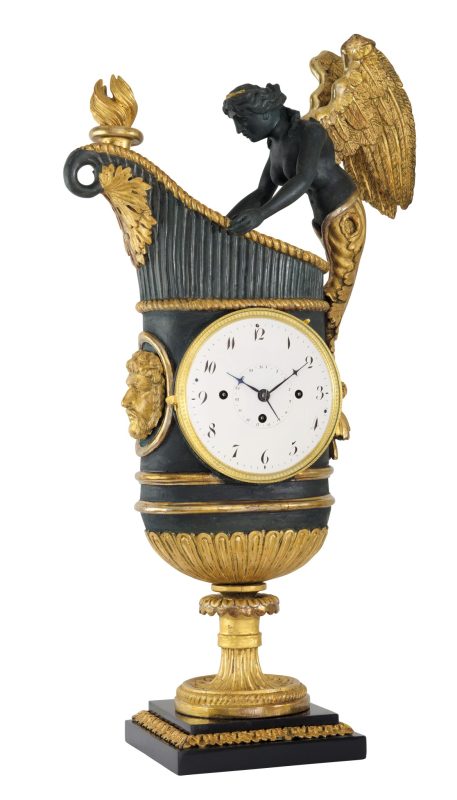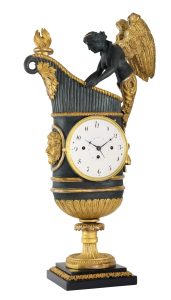Vienna, first quarter of the 19th century
- Case
- carved, ebonized and gilt lime wood, vase shaped case with handle in the form of a winged female figur and a mascaron of a bearded man, probably Hercules
- Dial
- enamel
- Movement
- anchor escapement, Viennese grande sonnerie on wire gongs, repeater, turn-off for strike, indication of date
- Height
- 26½ in
The eponymous furniture factory, founded by Joseph Ulrich Danhauser (1780–1829) had a decisive influence on the Austrian Biedermeier style. The academic sculptor created imaginative designs for furnishings of all kinds – from seating furniture, chests of drawers and chandeliers to racks for billiard cues – and thus ensured the stylish design of every area of upper middle-class Viennese life. In the spirit of neoclassicism, he included references to Greek and Roman antiquity, not only in the ornamentation of his pieces, but also in the forms of figural elements such as caryatids, nymphs, atlases, etc.
The present Viennese museum-quality mantel clock – a comparable piece can be found in the Museum of Applied Arts in Budapest – can be compared with many of Danhauser’s design drawings preserved today in the collection of the MAK Vienna. The case, designed in the shape of an antique vase and made of carved, ebonized and gilt lime wood, bears similarities to some of the vessels and centerpieces from the Danhauser workshop (e. g. MAK inv. no. KI 8971-1654).
Winged mythological female figures (some with lower bodies formed from acanthus leaves, some holding pitchers for the lamp oil in their hands) were a popular motif in Danhauser’s furniture, especially the chandeliers (e. g. MAK inv. no. KI 8971-1692 and MAK inv. no. KI 8971-1654). This artistically crafted sculptural timepiece can therefore be placed in the circle of the gifted furniture designer and was once the central eye-catcher of an elegant Viennese salon of the highest rank.

